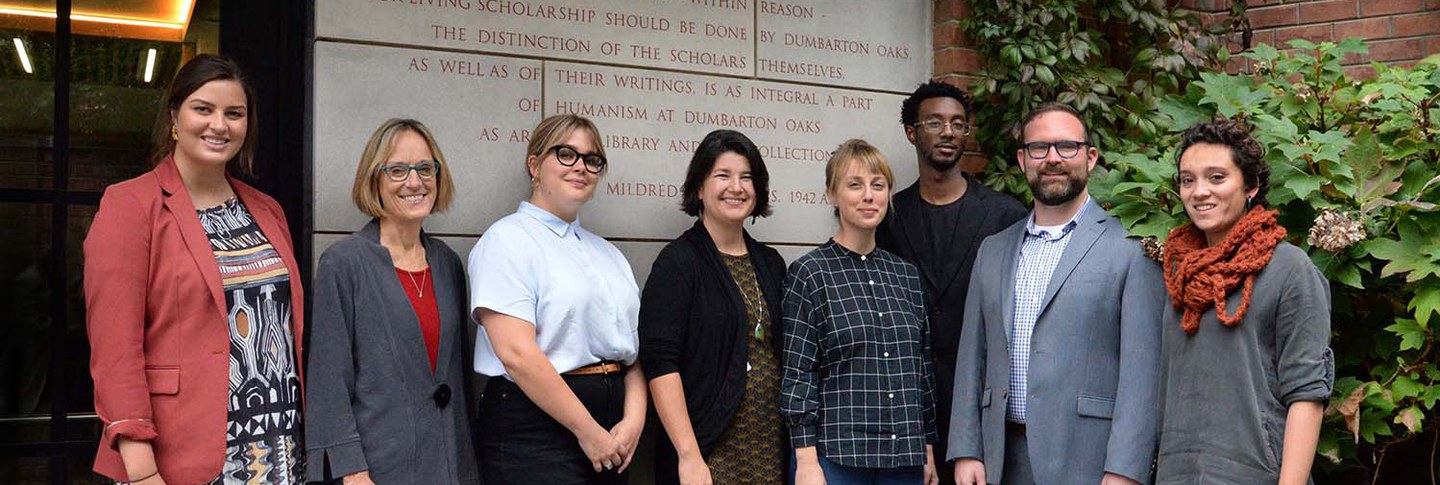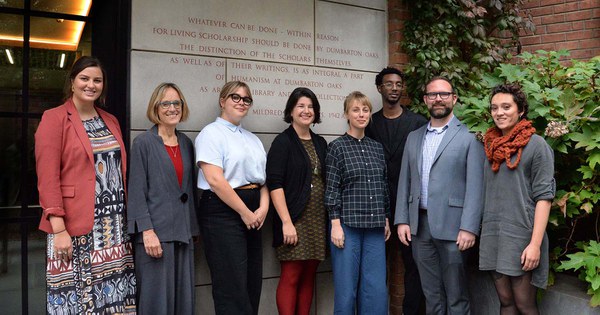Five recipients of the Mellon Conference Award reflect on this fall’s Garden and Landscape Studies colloquium, “Interpreting Landscapes of Enslavement.”
Alissa Ujie Diamond, University of Virginia, The Constructed Environment Program, PhD candidate
During the Colloquium, Sara Zewde commented, “what isn’t a landscape of enslavement in this country?” Ashley Rogers’s presentation reiterated this reality, which traced histories outside the plantation-focused “period of significance,” keeping relations of power and exploitation safely in the past and or dissipated to other sites. Rogers’s exploration of the continuities between slavery, postbellum agricultural regimes, and modern agrochemical industries drew often suppressed histories into direct relation with the social and spatial dynamics demonstrated today.
How could more institutions (including Dumbarton Oaks!) unravel the cross-scalar entanglements in space and time that shaped their sites, cultures and institutional structures? What would that exploration mean for the narratives our institutions are implicated in and held accountable to? What would this study mean for the futures of our institutions and power centers if “strategies for revealing and interpreting histories of slavery and the legacies of racial injustice” moved towards redressing and unraveling slavery’s aftermath?
The presentations highlighted the myriad complications that arise within institutions that simultaneously protect their legacies and missions, and answer to demands to examine their histories, many in contexts where founders saw institutions as mechanisms to protect and preserve the consolidation of privilege and power. But, what about spaces that are “everywhere” but do not have institutional or archival continuities that facilitate exploring histories of enslavement? What are the opportunities with Federal highways, subdivisions, or shopping malls? What do people, in the vein of Brian Palmer’s work on maintaining historically black cemeteries, already remember that is facing erasure and colonization?
Sasha Anemone, Cornell University, Master of Landscape Architecture candidate, 2020
The Colloquium helped both to broaden my exposure to methodologies and ideas peripheral to my research as well as deepening my understanding and contextualizing my knowledge of topics at the heart of my study.
The discussions on engaging with descendant communities as primary stakeholders in the interpretation of slavery at Montpelier, Monticello and Georgetown University were particularly interesting. While the modes of engagement that were presented would be out of the scope of my current project, hearing about the histories and methodologies of the three programs gave me a much better sense of sources to look to for oral histories and collaborative institutional/community interpretation. It was also helpful to hear the takeaways of people who have been engaged in these processes on questions of framing and presenting knowledge, even when these takeaways conflicted, such as the disagreements on reconstructing slave dwellings and other landscape features.
In Ashley Rogers’s talk, learning about the links between plantation cultivation and petrochemical industries in Louisiana helped put into an international context very similar patterns that I observed during fieldwork in Trinidad and Tobago. Her talk helped me clarify this complex connection in terms of regional and global economic shifts, patterns of land ownership, and racialized understandings of work and workers. Seeing research into a similar topic from a different discipline helped me consider source materials that are not often employed in design analysis and reminded me of the visual power of primary documents such as historic newspaper articles and correspondence.
Elizabeth Bray, University of Guelph, Bachelor of Landscape Architecture candidate, 2020
For my undergraduate thesis, I am attempting to unravel Nova Scotia’s entanglement in the North American slave trade. My research investigates the narratives told by the province’s monuments and landscapes, asking why certain parts of history are told both abundantly and thoroughly, while others are neglected.
Prior to attending the Garden and Landscape Studies Colloquium, “Interpreting Landscapes of Enslavement,” I was unsure as to effectively bridge the gap between history and design. However, after learning how leading designers, historians, archaeologist, interpreters, and scholars confront difficult parts of history and effectively translate these components into meaningful dialogue, ultimately allowing me to understand the power and importance of imagination as a tool.
Going forward—not only in my thesis, but also in my career—I am inspired to pursue social justice through landscape architecture design. While I have always been committed to equality, my time at the colloquium taught me that telling history accurately is not always easy or well-received by the broader public. However, it is critically important to represent both sides of narrative in today’s society.
Davey Hines, Illinois Institute of Technology, Master of Landscape Architecture and Master of Architecture candidate
The push for plantations now converted into museums to include the narratives of its enslaved inhabitants is refreshing to hear, however, I am relatively disturbed with the amount of many invested into to maintaining these homes of horror. Though erasure is an important problem of which to weary, I do not believe the societal benefit provided by these plantations’ histories warrant the amount of capital it demands to operate. The artifacts and stories of these places should be well documented and accessible, and the plantations should be closed, and that land repurposed. That the Whitney plantation has had tens of millions of dollars in funding while black descendants of Louisiana still live in inadequate conditions seems performative and gestural at best. Although these plantations have made efforts to connect with their direct descendants in a meaningful way, the attention and capital would be better spent uprooting systems of oppression that plague the descendants of the enslaved today. Those who spent their lives in captivity and faced abuse would be horrified to know that these places have been allowed to remain, while their descendants are still fighting for the equal citizenship Thomas Jefferson hypocritically decreed a right for all Americans. Projects like the restoration of the African American cemetery and the collection of the soil where African Americans were lynched are more powerful and more meaningful. These projects are about black people as individuals and American citizens as opposed to their roles as commodities for 18th- and 19th-century commercial production.
James Mealey, University of Massachusetts Amherst, Master of Landscape Architecture candidate, 2020
It’s easy to miss what you don’t know to look for. As I sat in the audience for the colloquium “Interpreting Landscapes of Enslavement” at Dumbarton Oaks, I felt a renewed appreciation for landscape’s contradictory powers of masking and revelation. It was through the medium of landscape that late-nineteenth-century neo-Confederates obscured the realities of slavery in the southern US and in recent years this same medium has been employed to reassert this history to powerful effect.
As an aspiring landscape architect, I gained through the day’s series of captivating presentations and panel discussions a timely reminder of the great responsibility inherent in any modification of the landscape. Also coming through in the work of the diverse presenters was the continuous thread that leads from these dark chapters in American history to the present, and the role that landscape plays as a record of our collective story. It is the duty of the landscape professions to illuminate and interpret this record for the general public, and to do so with clarity of vision and honesty.
I will bring these convictions forward with me as I complete my studies and embark on my professional career. I will also carry forward important unanswered questions. How can we convey the rich layers of historical meaning embedded in everyday landscapes, not only in designated historic places and sites of consciousness? And how can we think critically about our role as designers and planners as intermediaries of landscape, history, and our own time?

